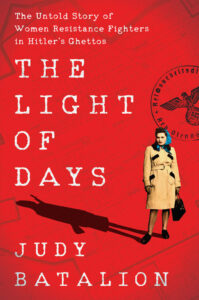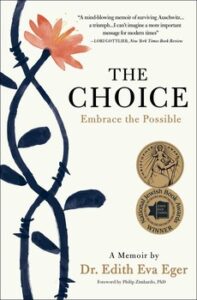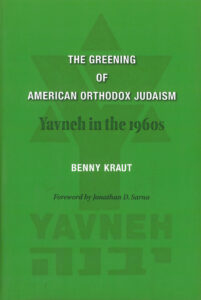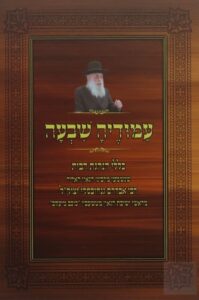TRADITION’s 2021 Book Endorsements – Part II

 TRADITION continues its yearly tradition of turning to our esteemed editorial board for endorsements for summer reading (read the feature introduction and first installment here). Below is the second of three installments of our sometimes stereotypical, sometimes surprising book picks.
TRADITION continues its yearly tradition of turning to our esteemed editorial board for endorsements for summer reading (read the feature introduction and first installment here). Below is the second of three installments of our sometimes stereotypical, sometimes surprising book picks.
The next and final round in this series can be found here — read the series conclusion and learn the identity of the winner in our contest to predict the most book picks.
Benny Kraut, The Greening of American Orthodox Judaism: Yavneh in the 1960s (HUC Press)
Joel B. Wolowelsky
Benny Kraut’s history of Yavneh: The Religious Jewish Students Association reminds us of so much of Jewish life in the past—and what is missing from the present.
Yavneh was a child of the sixties. Modern Orthodox yeshiva graduates were finding their way to college campuses and found their needs unmet. There were few shiurim on campus; there were few opportunities for men and women from various campuses to meet each other; there were Saturday exams and required meal plans serving up treif food; and there were few Hillel directors willing to fight for these students. Yavneh members organized to address these and other issues, and Kraut’s book reminds us exactly how they did so. After a decade or two, most of these issues were resolved, and Yavneh, rather than looking for how to reinvent itself to remain a relevant organization ceased operation. (Fortunately no one lost their jobs—Yavneh was always student- and volunteer-led.)
There are, however, some things that are sorely missing from that era, and the read brings some of them home. Jewish organizations were willing to support students without demanding formal affiliation. There was no “parent” organization for Yavneh, although the Orthodox Union provided a rent-free office and the American Zionist Youth Foundation supported some of its programs. They did this without insisting on any control. Orthodox leaders with different approaches put their differences aside to provide support and advice. The first three National Advisory Chairmen were Rabbis Norman Lamm, Aharon Lichtenstein, and Yitz Greenberg. Could we imagine such a threesome working together now regularly for a student group that met for discussion and advice, not instructions? Yavneh leaders met with a group of rashei yeshiva including Rabbis Moshe Feinstein, Shneur Kotler, Yaakov Ruderman, and Yaakov Weinberg. Such rabbis, in our contemporary days, would probably not come together to meet with student leaders of a co-ed university organization. Other surprises await the reader.
True, there are professional organizations working to meet the needs of Orthodox students on campus: Chabad houses, the OU’s JLIC, Hillels sensitive to Orthodox needs, and others. But where are the organizations of students out to change the world themselves? Reading Kraut’s book might trigger some important thoughts—and perhaps even actions.
Joshua Teplitsky, Prince of the Press: How One Collector Built History’s Most Enduring and Remarkable Jewish Library (Yale University Press)
Jeffrey Saks
The great bibliophile R. David Oppenheim (1664-1736) was a scion of rabbinic and wealthy families, with deep connections to the courts of Europe. He served as the rabbi of Prague, among a list of other prominent positions, including Nasi of Eretz Yisrael and Rabbi of Jerusalem (despite never having traveled to the Holy Land—it’s a story, read the book).
Oppenheim’s most enduring legacy, the topic of Joshua Teplitsky’s deeply researched and engaging Prince of the Press, remains his vast collection of over 8,000 Jewish books and manuscripts, containing works from classical rabbinic texts to Yiddish songbooks and plays, to the types of ephemera not usually preserved for posterity (broadsheets and the like). Many of these works exist today only thanks to having been preserved on his shelf in singular copies.
Teplitsky tells us that Oppenheim’s library “provided him with the vehicle for shaping his place in the religious and social culture of the early modern period. His library-as-archive contributed to administering the autonomous life of early modern Jews in Moravia and Bohemia, across the German lands, and into the Jewish courts of Italy. By amassing, archiving, and mobilizing information, Oppenheim used his collection to interweave personal prestige with institutional practice.”
Through the library, Oppenheim succeeded in positioning himself “as having a level of expertise unavailable to others—a tangible symbol of superiority in Jewish society’s most revered arena.” But he did not horde these riches for himself alone. “Acquired with family wealth, and symbolic of courtly influence, the library was used by both Oppenheim and a constituency of rabbinic and communal leaders to shape the legal, ritual, and daily lives of an even wider array of ordinary Jews in early modern Europe.” The collection, especially its manuscripts, helped reshape the textual contours of Jewish learning – especially the “importing” and distribution of Sefardic Rishonim into mainstream learning in Ashkenazic Jewry. While he was not alone in making this happen, his collection significantly accelerated the trend. For example, Oppenheim’s manuscript collection supplied the texts for the first published version of Ritva on various tractates in Amsterdam (1729).
Perhaps the most interesting section of this already fascinating tale is the library’s afterlife, and how it was preserved intact over centuries until its arrival as a very significant component of the Judaica department at Oxford University’s Bodleian Library. Its removal to one of the few sites in England spared bombings of World War II rescued Oppenheim’s collection from what would have been its inevitable fate had it remained on the continent. The destiny of other libraries not shielded from the Nazis’ reach is explored in two other excellent books published the same year as Prince of the Press: Dan Rabinowitz’s The Lost Library: The Legacy of Vilna’s Strashun Library in the Aftermath of the Holocaust (Brandeis) and Elisabeth Gallas’ A Mortuary of Books: The Rescue of Jewish Culture After the Holocaust (NYU Press). Taken together, these three books remind us that not only “of the making of many books there is no end,” but that the collecting of those books, and the stories they tell as cultural agents, is similarly endless.
Judy Battalion, The Light of Days: The Untold Story of Women Resistance Fighters in Hitler’s Ghettos (HarperCollins)
Rivkah Blau

In the first years following the Holocaust, survivors may have wanted to tell what had happened in the Shoah, but did not always find an audience. One had written a book in Yiddish in 1946, Freuen in di Ghettos, which recounted women’s heroic roles in the resistance. Sixty-one years later Judy Batalion happened upon a dusty copy of the book and was astonished; she had never heard its tales of courageous women who smuggled food into the ghettos, sustained Jews in hiding places, carried cash, brought messages from one resistance group to another, baked loaves of bread with guns in the center, sabotaged German supply lines, assassinated Nazis. She spent years gathering accounts that led to her writing The Light of Days.
These young women were intelligent, quick-thinking, resourceful, and dedicated to saving Jews. They had belonged to youth movements where they had experienced group solidarity and worked together for an ideal. They had advantages over Jewish men in pretending to be Poles: many had gone to Polish schools and spoke without any Yiddish accent; they had Polish friends and knew the culture; they carried no mark of Jewishness on their bodies.
The danger was constant. If they were caught, they were imprisoned and starved, beaten, and tortured in every way the Nazis invented. But they insisted they were Polish and did not reveal the network behind them. Renia, a major figure in the resistance, kept her mind intact while her body was brutalized. Details of what the women endured make one shudder at the insane cruelty of the Nazis. As the hangmen tightened the noose around her neck, one woman called out to the prisoners who were forced to watch, “Sisters, revenge!” The book gives the lie to claims of Jewish submissiveness. (Because the content and length of the book would likely overwhelm children, Batalion published a Young Readers’ Edition — half the length and omitting the most traumatic depictions of torture.)
After the war the young men and women married, created families, and many settled in Israel. When Batalion met Renia’s children in Haifa, they described their mother as a vibrant woman, determined to enjoy life. Her name stands atop a list of 272 women of valor whose names are memorialized under the word Yizkor on the book’s inside cover.
The recent New York Times obituary for Faye Schulman, born Faigel Lazebnik, a heroine in The Light of Days, includes a photo of her in a snow-covered forest; she is aiming a rifle. She was a partisan, a photographer who saved her pictures showing the cruelty of the Germans and the courage of the Jews. She said, “I want people to know that there was resistance. Jews did not go like sheep to the slaughter. I was a photographer. I have pictures. I have proof.”
Judith Bleich, Defenders of the Faith: Studies in Nineteenth- and Twentieth-Century Orthodoxy and Reform (Touro University Press)
Michael Shmidman, Editor Emeritus

Defenders of the Faith
Prof. Judith Bleich, masterful teacher and distinguished scholar of modern Jewish intellectual history, revered rebbetzin in the New York Orthodox community and beyond, is an eminent authority on the emergence of the modern movements of Orthodox and Reform Judaism and the history of the polemics between those movements. A selection of her published essays in the latter area appeared recently as Defenders of the Faith: Studies in Nineteenth-and Twentieth-Century Orthodoxy and Reform. Every essay is characteristically erudite and repercussive, of essential importance to scholars in the field. All, as always, are authored with meticulous attention to historical detail, rigorous analysis of primary and secondary sources, and elegantly crafted prose. [Some of the collected essays originally appeared in TRADITION, where Bleich has been a long-time member of the editorial board.]
A particularly striking indication of the immense respect accorded Bleich’s scholarship, especially in the area of the interaction between Orthodoxy and Reform, is the fact that the jacket cover blurbs for the book were written not only by two of the leading academicians representing Orthodox Judaism, Professors David Berger and Shnayer Leiman, but also by two of the leading scholars representing Reform Judaism, Professors David Ellenson and Michael Meyer. To quote one sentence from the comments of Ellenson: “The erudition of Bleich on the topics of Orthodox and Reform Judaism and their emergence and evolution in the 19th Century is unsurpassed, and her vast knowledge and keen analysis are present on every page of this book.”
The book’s topics include: Rabbinic Responses to Nonobservance in the Modern Era; The Emergence of an Orthodox Press in Nineteenth-Century Germany; The Circumcision Controversy in Classical Reform in Historical Context; Clerical Robes: Distinction or Dishonor?; Intermarriage in the Early Modern Period; Military Service: Ambivalence and Contradiction; The Testament of a Halakhist [Rabbi Jacob of Lissa]; Between East and West: Modernity and Traditionalism in the Writings of Rabbi Yehi’el Ya‘akov Weinberg; Liturgical Innovation and Spirituality: Trends and Trendiness.
A perceptive and felicitously formulated introduction to the volume chronicles the resurgence of Orthodoxy, of Torah scholarship and education, in post-World War America. After noting the predictions of some nineteenth-century figures in the Wissenschaft and Reform movements concerning the inevitable demise of Orthodoxy in the modern world, the author questions: “What, one wonders, would be the reaction of those individuals were they magically transported to the twenty-first century and shown the wall-to-wall bookshelves within synagogues and houses of study from New York to Los Angeles, from Sydney to Perth, from Hong Kong to London, from Berlin to Moscow, from Boston to Buenos Aires, from Safed to Beersheba, all filled from floor to ceiling with rabbinic works, old and new, revised editions, annotated, critical editions of classical texts and innumerable current halakhic writings in Hebrew, French, English, Spanish and, of late, even in Russian, as well as, once more, in German?” Indeed, we marvel at these miracles.
Edith Eva Eger, The Choice: Embrace the Possible (Scribner)
Chaim Strauchler
 One morning, the psychologist Edith Eger saw two patients back to back, both mothers in their forties. The first woman had a daughter who was dying of hemophilia. She spent most of her visit crying, asking how God could take her child’s life. Eger’s next patient had just come from the country club, not the hospital. She, too, spent much of the hour crying. She was upset because her new Cadillac had just been delivered, and it was the wrong shade of yellow.
One morning, the psychologist Edith Eger saw two patients back to back, both mothers in their forties. The first woman had a daughter who was dying of hemophilia. She spent most of her visit crying, asking how God could take her child’s life. Eger’s next patient had just come from the country club, not the hospital. She, too, spent much of the hour crying. She was upset because her new Cadillac had just been delivered, and it was the wrong shade of yellow.
Eger explains that the tears shed over the car’s color were really tears of disappointment over the bigger things in this woman’s life that hadn’t worked out the way she had hoped—a lonely marriage, a son who had been kicked out of yet another school, the aspirations for a career she had abandoned in order to be more available for her husband and child.
While most profiles of this bestselling book focus on Eger’s Holocaust survival, the book is actually about something else she is communicating to us. Like the tears of the mother whose daughter is dying, Eger uses the Holocaust to describe an approach which she then assigns to the relatively little upsets of her patients and readers (their Cadillacs). The book lays out a methodology for responding to trauma which can be summarized in the book’s title. Like Viktor Frankl before her, she argues that we must each choose our locus of meaning in deciding upon our life’s story.
Eger elucidates her psychotherapeutic methodology through the long runway of her own survivor story. This story focuses just as much on her relationship dysfunction after the Holocaust, as it does on her experiences during the war. Many Holocaust survivors’ narratives have been produced over the years with the same narrative arc. Eger’s is specifically worthwhile in her unwillingness to end her story with liberation or professional success. She charts a story where the Holocaust begins many choices—those that she both makes herself and those she guides her patients to make themselves.
Abraham Rabinovich, The Boats of Cherbourg: The Navy That Stole Its Own Boats and Revolutionized Naval Warfare (Seaver Books)
Elisheva Rabinovich, Editorial Assistant
 Israel’s military history is generally fascinating, and its naval history is especially so. But it doesn’t get the same attention as the tank charges in Sinai, or the air force in 1967. So for anyone looking for a brief but dense deep dive, I recommend starting with The Boats of Cherbourg.
Israel’s military history is generally fascinating, and its naval history is especially so. But it doesn’t get the same attention as the tank charges in Sinai, or the air force in 1967. So for anyone looking for a brief but dense deep dive, I recommend starting with The Boats of Cherbourg.
Starting with the Egyptian sinking of the Israeli destroyer Eilat following the Six-Day War, The Boats of Cherbourg follows the Israeli Navy’s mission to sneak new boats out of France after President de Gaulle placed an embargo on them. It follows the boats to Haifa where they, with a tiny budget, were given cutting-edge missile and anti-missile defense technologies.
“Celebrated at the time, the Cherbourg boat episode was part of a larger story… [this] is a tale of intrigue and political maneuvering: why the Israeli navy gambled its future in the then-unproven concept of missile-warfare at sea; how, alone, it pioneered a missile and antimissile arsenal and withstood unscathed the first and to date only missile-to-missile sea battles in history, during the Yom Kippur War.”
Abraham Rabinovich, my great uncle and a former reporter for The Jerusalem Post, started to put together this mostly forgotten episode of history while covering the Yom Kippur War in 1973, and in its aftermath. He learned that while the army and air force were overwhelmed by the near-disaster of the war, the navy had been incredibly successful. And he was able to trace it back to the once well-known but now largely forgotten story about the boats smuggled out of France. This book has it all: French politics, Soviet missiles and Syrian fleets. But what makes it so fun is the incredible chutzpah of the Israeli navy.
R. Avraham Genachovsky, Amudeha Shiva: Kelalei Hanhagat ha-Bayit
Menachem Genack
This work is a compilation of the classes on shalom bayit delivered by Rabbi Avraham Genachovsky (1936-2012), my late cousin and a rosh yeshiva of Yeshivat Kochav mi-Yaakov – Tchebin. R. Avraham was renowned as a talmudic genius, but he was no less a genius in the realm of hesed. To give one characteristic example: Once, a student visiting R. Avraham on Shabbat accidentally rang the doorbell. Instead of answering the door right away, R. Avraham changed into pajamas and only came to the door after the student had been knocking for a few minutes. This way, R. Avraham reasoned, the student would assume that R. Avraham had been sleeping and had not heard the bell ring; the student would thus be saved from embarrassment. On another occasion, R. Avraham saw two children crying on the porch of their apartment. Since he had no other way to reach them, he took out a ladder and climbed up so he could speak to and comfort the children.
This sefer, compiled and edited by R. Alter Altman in 2016, is based on the seven principles that Maimonides enumerates for how a husband must treat his wife (Hilkhot Ishut 15:19): “Our Sages commanded that a man honor his wife more than his own person, and love her as he loves his own person. If he has financial resources, he should increase her well-being in accordance with his resources. He should not be too intimidating, and he should speak with her gently; he should be neither depressed nor angry.” The volume is pitched towards husbands, new and veteran (it originated in a series of shiurim and conversations for young hattanim), but contains insights for both men and women seeking to build a harmonious home-life to further the goals of a healthy marriage and strong family founded on Torah.
R. Avraham was a living example in the area of shalom bayit, and the editor has adorned the book with illustrative anecdotes from R. Avraham’s own life as well. For instance, when his wife was speaking to him, R. Avraham would be sure to close his Gemara, devoting his full focus to what she had to say instead of dividing his attention. The topic of this sefer falls into that category described by Mesillat Yesharim in the introduction to his work – those concepts that people already know, but nevertheless must constantly be reminded of. As well-known as they are, Ramchal writes, so are they ignored and neglected in the same measure. R. Avraham’s reflections on Maimonides’ foundational principles of marriage are a worthy reminder of Judaism’s ideals in this most significant of relationships.
Bezalel Naor, Navigating Worlds: Collected Essays (Kodesh Press)
Shlomo Zuckier
 This summer I have the pleasure of reading through the recently released Navigating Worlds: Collected Essays by Rabbi Bezalel Naor, containing essays authored over the past 15 years. In his characteristic witty and creative writing style, R. Naor weaves together incisive readings of traditional texts with a broad knowledge of Jewish and general thought and a familiarity with the culture of the Gedolim of previous generations that provides an added flavor to his writings.
This summer I have the pleasure of reading through the recently released Navigating Worlds: Collected Essays by Rabbi Bezalel Naor, containing essays authored over the past 15 years. In his characteristic witty and creative writing style, R. Naor weaves together incisive readings of traditional texts with a broad knowledge of Jewish and general thought and a familiarity with the culture of the Gedolim of previous generations that provides an added flavor to his writings.
The essays are often short, developing an insight in reading a text and fleshing it out, with notes offering fascinating historical details or other enjoyable trivia. To provide one example, the chapter “A Meditation of Masekhet Megillah” features the intriguing subtitle “Thanks to Three Liberated Litvaks: Rabbi Zadok Hakohen, Emmanuel Levinas, and M. Shoshani.” It lays out Rav Tzadok’s idea that talmudic aggada always relates to its nearby legal material and Emmanuel Levinas’ project of reading aggada as literary units. With that methodological frame, R. Naor then goes about analyzing the sugya, which discusses whether Tiberias qualifies as a walled city for Purim, questioning whether its sea border qualifies as a wall, and transitions into an aggada about Rome. These bookends to the talmudic passage, he suggests, serve as literary foils to one another, and the discussion is a talmudic meditation on the encroaching reality of the Roman Empire, as the anshei Yavan emerge from the sea, threatening the bordering Tiberias, unless it can sufficiently construct its wall. The reader is treated not only to this insightful talmudic reading, but also to footnotes featuring lengthy excurses on Rav Tzadok’s methodology and the enigmatic Monsieur Shoshani, a teacher of Levinas, Elie Wiesel, and others.
These are generally not systematic essays but collections of insights into all areas of Torah, ranging over Lomdus and Kabbalah, the Rav and Rav Kook, Parasha and Gemara, messianism and interfaith issues, and everything in between. In that sense, a volume of collected essays suits this author particularly well in light of his proclivity for sharp insights rather than extensive treatises.
One note to the reader: While the book is categorized by sections – parshiyot ha-Torah, dappei Gemara, topical sections, and book reviews – they do not fully capture the genres of this multifarious work, although they might point to the origin of the insight – biblical, talmudic, topical, or some other book. Experiencing the rich intermingling of topics and the surprisingly refreshing intellectual jaunts between different texts, thinkers, and topics is one of the pleasures of reading this very original contemporary thinker, teacher, and author.
This is the second of three installments in this feature. Read the first round of picks here; read on for the series finale.



